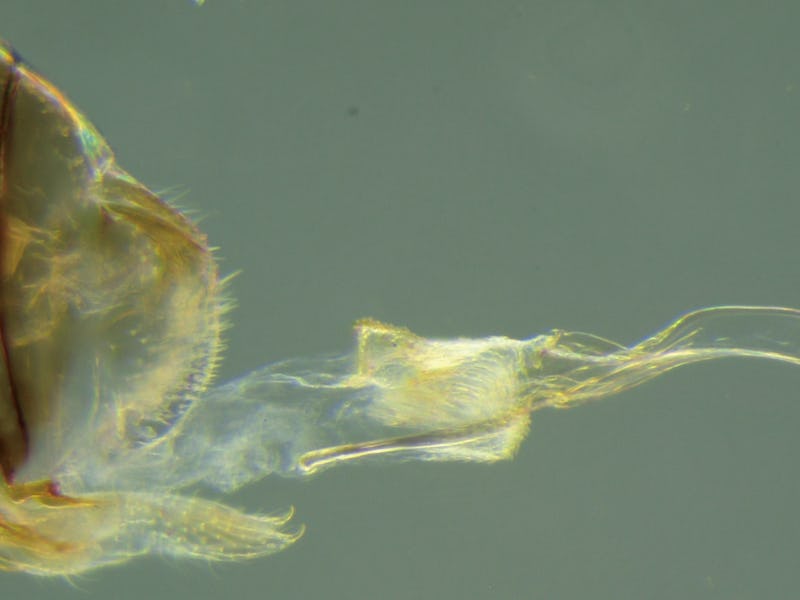Species With Female Penises and Male Vaginas Evolved Twice, Says Scientist
"I couldn't conceive a disadvantage for this structure."

For the vast majority of species, the easiest way to tell an animal’s biological sex is to check out its junk. Does its sex organ elongate and stick out sometimes? A male, in most cases. Is it more concave than it is convex? Probably a female. But traditional notions of penises and vaginas are not to be taken for granted, says a new paper in Biology Letters. In at least two genera of southeastern Brazilian insects, vaginas and penises are the exact opposite of what you’d expect.
In the paper, a team of scientists led by Kazunori Yoshizawa, Ph.D., an associate professor of systematic entomology at Hokkaido University, explore the evolutionary history of two genera of insects in which the females have penis-like organs and the males have vagina-like organs. Falling under a tribe of cave psocids known as Sensitibillini, these two genera — Afrogtrogla and Neotrogla — have sex organs that have, understandably, confounded scientists since they were discovered four years ago. The new finding in the paper is that female Afrogtrogla and Neotrogla have penises of different sizes and shapes and are not part of the same clade (branch) of the phylogenetic tree — which means that the strange organs evolved independently twice.
"The reversed direction of sexual selection must be the most important factor which drove the evolution of the female penis.
The most likely reason these organs evolved, Yoshizawa tells Inverse, is because of the unusual “direction” in which sexual selection occurs in Afrogtrogla and Neotrogla. Sexual selection refers to the process by which members of one sex compete the other; in most animals, it’s the males who are in competition to impregnate females. In these two Sensitibillini genera, however, females compete to get a hold of male sperm, and it’s the males that are choosy.
“The reversed direction of sexual selection must be the most important factor which drove the evolution of the female penis,” says Yoshizawa.
Neotrogla females have a penis-like organ called a gynosome.
The dry and nutrient-poor caves in which these insects live are thought to make repeated mating — and life in general — difficult. And so, when a female mates with a male, it’s in her best interest to hold on to his sperm — not just because it can help her procreate, the team notes in another paper, but also because she can consume it for nutrition when food in the barren caves hits a low.
Part of the way a female can optimize the sperm-capturing process is to have sex organs that literally hold on to a male. During intercourse, the female inserts her organ — called a gynosome — into the male, where it stays for 40 to 70 hours, receiving huge packets of sperm all the while. Accordingly, female neotrogla have spiky penises, much like male cats. This is the role of the male sex organ in most species: The male duck, for example, has a corkscrew-shaped penis that helps it insert its sperm further into a vagina than other males. Some animals evolved a penis bone to allow for prolonged sex.
Some male animals have a penis bone to allow for prolonged intercourse.
But this is not the only reason these genitals developed. “[Among] the many animals with reversed direction of sexual selection, Neotrogla and Afrotrogla are the only example to date in which female penis evolved,” says Yoshizawa. “We recently discovered a specialized switching valve in Neotrogla, and similar structure exists also in Afrotrogla.”
"I couldn’t conceive a disadvantage for this structure.
In a paper published in eLife in October, Yoshizawa’s team wrote: “Females have a penis-like intromittent organ to coercively anchor males and obtain voluminous semen.”
Meanwhile, the presence of “male vaginas” in Afrogtrogla and Neotrogla suggest that the male sex organs co-evolved alongside those of females. This provides support for the idea that male mate choice drove the development of the female penis in these insects, just as female mate choice is thought to have drive the development of various types of penises (barbs, spikes, and so on) in most other animals.
Asked whether there was a downside to having a female penis for these animals, Yoshizawa said: “For female Neotrogla and Afrotrogla, having the penis should be greatly advantageous. I couldn’t conceive a disadvantage for this structure.”